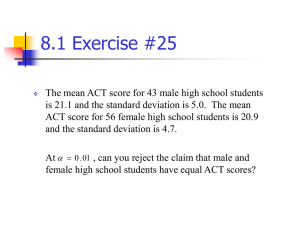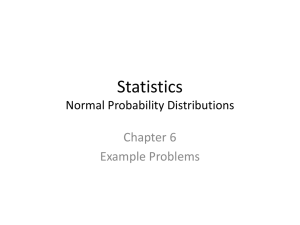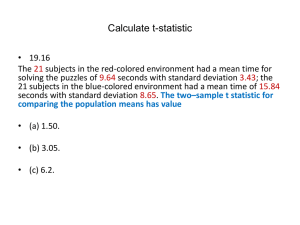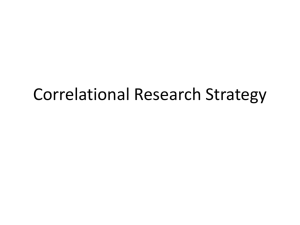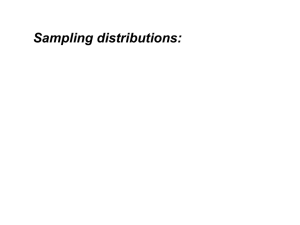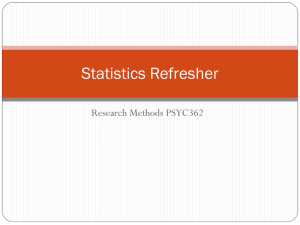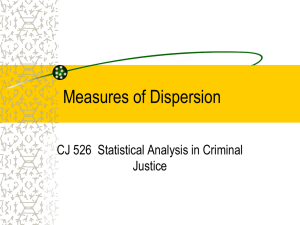Lecture Notes - Webpages at SCU
advertisement
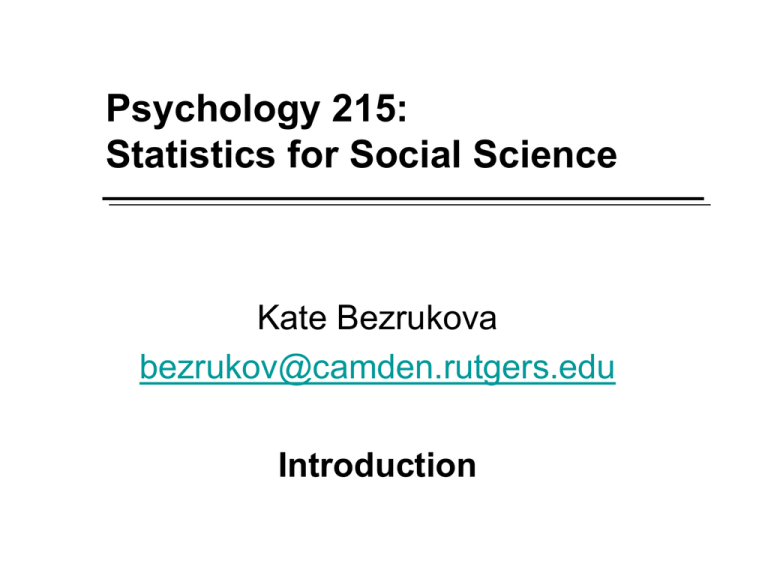
Psychology 215: Statistics for Social Science Kate Bezrukova bezrukov@camden.rutgers.edu Introduction Introduction • Our Increasingly Quantitative World!!! • Data are not just numbers! but numbers that carry information • Purposes: – producing trustworthy data – analyzing data to make their meaning clear, and – drawing practical conclusions from data Basic Idea of Statistics: To make inferences about a population using data from only a sample population inference about population (using statistical tools) sample of data Overview of Course • Methods of data collection – summarizing data • Visualizing data – correlation and association • Standard scores and Normal Curve – statistical inference • Statistical tests – necessary skills Variables Statistics vs. Parameters • sample – statistics c – carries uncertainty • population – parameter – carries no uncertainty is there any interest in a group larger than one you have? 1. if “yes” - sample 2. if “no” - population Terms • Data - numbers collected for purpose in a particular context – Case/observational unit • Variability – fundamental principle. • Variables – any characteristics of a person/thing that can be assigned a number or category – measurement (continuous) variables – assumes a range of numerical values – categorical variables – simply records a category designation. Types of Variables Variables = Aspect of a testing condition that can change or take on different characteristics with different conditions. • Dependent Variable (DV) • Independent Variable (IV) • Extraneous Variable – Confounded Variables Graphs Distributions • data distribution – pattern of variability. – the center of a distribution – the ranges – the shapes • simple frequency distributions • grouped frequency distributions – midpoint Graphic Presentation of Data the frequency polygon (quantitative data) the histogram (quantitative data) the bar graph (qualitative data) Distributions • Bell-Shaped (also known as symmetric” or “normal”) • Skewed: – positively (skewed to the right) – it tails off toward larger values – negatively (skewed to the left) – it tails off toward smaller values Measures of Central Tendency Mean c= S c Sc N an instruction “to add” mean characteristics: 1. 2. c a score of observations N number of observations S (c c ) = 0 2 (c-c ) S = minimum, “least squares” Median & Mode • MEDIAN divides a distribution of scores (always arrange in order!) into two parts that are equal in size • median location: – if uneven N – actual score – if even N – mean of the middle two scores • MODE is the most common value, i.e., the most frequently occurring score. Simple Frequency Distributions raw-score distribution name Student1 Student2 Student3 Student4 Student5 Student6 Student7 Student8 X 20 23 15 21 15 21 15 20 frequency distribution Mean f X 3 2 2 1 15 20 21 23 c= Sfc N Measures of Variability Measures of Spread: Range is simply a numerical distance b/w the highest score and the lowest score – how many hours did you sleep last night? – how much sleep do you usually get on a typical night? Interquartile range tells the range of scores that make up the middle 50 percent of the distribution. • IQR = 75th percentile – 25th percentile • a location value (.25 x N) – similar to finding the median • interpretation: “the middle 50 percent of the scores have values from XXX to YYY” Deviation Scores = raw score – mean for samples: X – X for populations: X – 1. 2. 3. if X > X, positive deviation scores if X < X, negative deviation scores if X = X, deviation scores = 0 interpretation: the number of points that a particular score deviates from the mean (S (X – X) = 0). Standard Deviation s - is used to describe the variability of population (s is parameter) s - is used to estimate s from a sample of the population (s is statistics) S - is used to describe the variability of a sample when we have no desire to estimate s. (S – statistics) – Choosing the correct SD: 1. 2. – how the data was gathered -- was sampling used? generalization – purpose of the data? Formulas: • • deviation-score formula raw-score formula Deviation-Score Method s= where 2 ) S (XN S= s = standard deviation of population S = standard deviation of sample N = number of scores 1. 2. 3. 4. 2 ) S (X- X find a deviation score for each raw score square the deviation score add them up divide this sum by N and find a square root N Raw-Score Method s= 2 2 X) (S SX - N N where S X2 = sum of the squared scores (S X)2 = square of the sum of the raw scores N = number of scores 1. 2. 3. 4. square the sum of the raw scores and divide by N square each score and add them up subtract 1 from 2 divide this difference by N and find a square root Standard Deviation (Sample) S= S (X- X N-1 S= )2 S S= 2 2 X) (S SX - 2 2 fX) ( S fX - N N-1 SfX2 -squaring, multiplying, summing - (SfX)2 - multiplying, summing, squaring - N N-1 Variance • the number before taking the square root 2 2 S(X-) S (x-x) 2= s2 = S N N-1 • • • • analysis of variance N – population N – 1 – sample S(x-x)2 – sum of squares Other Descriptive Statistics Combination Statistics: z scores • standard scores are usually used to compare two scores from different distributions • positive z scores = raw scores > mean • negative z scores = raw scores < mean • the absolute value of the z score |z score| tells the number of standard deviations the score is from the mean X-X z= S Sz = 0 because S (X – X) = 0 How much difference is there? Effect Size Index “d” • describes the size of the difference between two distributions |1- 2| d= s always a positive number! small effects medium effects large effects d = .20 d = .50 d = .80 “huge”, “half the size of small”, “somewhat larger than”, spooled = (s12+ s22) / 2] “intermediate between” Descriptive statistics report: Boxplot - minimum score - maximum score - lower quartile - upper quartile - median - mean - the skew of the distribution: positive skew: mean > median & high-score whisker is longer negative skew: mean < median & low-score whisker is longer Report: 1) boxplot (draw) 2) effect size index (calculate) 3) story (write): a) central tendency, b) form of the distributions, c) overlap of distributions, d) interpretation of the effect size index EXAMPLE: A descriptive statistics report on “Marriage Ages” 1. The graph shows boxplots of marriage ages of women and men. +++++++++insert your boxplot here+++++++++ 2. 3. 4. 5. The mean age of women is 35 years old; the median is 33 years old. The mean age of men is 38.64 years old; the median is 34 years old. The marriage ages for both women and men are positively skewed. More women and men get married at the younger age*. Although the two distributions overlap, the middle 50% of the men are somewhat older than the middle 50% of the women. The difference in means produces an effects size index of .32. This value is somewhat larger than a small effect size. Correlation and Regression Correlation Coefficient a correlation coefficient (r) provides a quantitative way to express the degree of linear relationship between two variables. • Range: r is always between -1 and 1 • Sign of correlation indicates direction: - high with high and low with low -> positive - high with low and low with high -> negative - no consistent pattern -> near zero • Magnitude (absolute value) indicates strength (-.9 is just as strong as .9) .10 to .40 weak .40 to .80 moderate .80 to .99 high 1.00 perfect Pearson product – moment correlation coefficient: Formulas Invented by Carl Pearson and used to describe the strength of the linear relationship between two variables that are both either ratio or interval variables. Definitional Formula S ( zx zy ) r= N where r = Pearson product-moment correlation coefficient zx = a z score for variable X zy = a z score for variable Y N = number of pairs of X and Y values Computational Formulas raw-score formula The rule of thumb Correlation coefficient should be based on at least 30 observations Pearson product – moment correlation coefficient: Blanched Formula r= ΣΧΥ - (Χ)(Υ) N (Sx) (Sy) where X and Y are paired observations XY = product of each X value multiplied by its paired Y value X =mean of variable X Y =mean of variable Y Sx =standard deviation of X distribution Sy =standard deviation of Y distribution N = number of paired observations Correlation Coefficient: Limitations 1. Correlation coefficient is appropriate measure of association only when relationship is linear 2. Correlation coefficient is appropriate measure of association when equal ranges of scores in the sample and in the population (truncated range) 3. Correlation doesn't imply causality – – – Using U.S. cities a cases, there is a strong positive correlation between the number of churches and the incidence of violent crime Does this mean churches cause violent crime, or violent crime causes more churches to be built? More likely, both related to population of city (3d variable -lurking or confounding variable) Coefficient of Determination r2 tells the proportion of variance that two variables in a bivariate distribution have in common. Introduction to Linear Regression linear regression is the statistical procedure of estimating the linear relationship between Y and X Y = a + bX, where X and Y are variables representing scores on the Y and X axes, b = slope of the regression line a = intercept of the line with Y axes positive slope -- if the highest point on the line is to the right of the lowest point negative slope – if the highest point on the line is to the left of the lowest point Regression Coefficients Sy b = r Sx, where r = correlation coefficient for X and Y Sy = standard deviation of the Y variable Sx = standard deviation of the X variable a = Y – bX, where Y = mean of the Y scores b = regression coefficient X = mean of the X scores Introduction to Probability What are the odds that a card drawn at random from a deck of cards will be an ace? the probability is 4/52 Theoretical Distributions and Theoretical Probabilities • probabilities range from .000 to 1 • the expression p = .077 means that there are 7.7 chances in 100 of the event to occur. 4 3 2 1 Ace 2 3 4 5 6 7 8 9 10 J Q K Theoretical and Empirical Distributions • theoretical distributions (logic, math) • empirical distributions (observation) The Standard Normal Distribution 1. the mean, median and mode are the same score on the X axis where the curve peaks 2. the area to the left or right of the line = 50% of the total area 3. the tails of the curve are asymptotic to the X axis – they never cross the axis but continue in both directions indefinitely 4. the inflection points are where the curve is the steepest (-1s and +1s) The Normal Distribution table (Table C in Appendix C) The Table C can be used to determine areas (proportions) of a normal distributions and obtain the probability figures. • Column A contains a z score • Column B -- the area b/w the mean and the z-score • Column C -- the area beyond the z score • all the proportions hold for - z because the curve is symmetrical EXAMPLE: The College Frisbee Golf Course On the average, it takes 27 throws to complete the College Frisbee Golf Course. The standard deviation about this mean is 4. Questions that we can answer: 1. finding the proportion of a population that has scores of a particular size (e.g., what proportion of population would be expected to score 22 or less?) – interpretation: there are XX.XX chances in 100 that players would have 22 or less throws. 2. finding the score that separates the population into two proportions (e.g., if 950 students played and a prize was given for scoring 20 or less, how many would get prizes?) – interpretation: XX of the 950 people would get prizes. Example: The College Frisbee Golf Course. Cont’d 3. finding the extremes scores in a Population (e.g., suppose an experimenter wanted to find some very good Frisbee players to use in an experiment. She decided to use the top 10 percent from the CFGC. What is the cut-off score?) • interpretation: in order to be considered as a very good Frisbee player, you need to have a XXX score or higher. 4. finding the proportion of the population between two scores (e.g., what proportion would score between 25 and 30?) • interpretation: there are XX.XX chances in 100 that players would score between 25 and 30. Samples, Sampling Distributions, and Confidence Intervals Sampling The essential idea of sampling is to learn about the whole by studying a part Two important terms: 1. 2. • population – the entire group of people or objects sample -- a (typically small) part of the population Biased Sampling -- a tendency to systematically overrepresent / underrepresent certain segments of the population – convenience samples – voluntary response Random Samples • Random sample – any method that allows every possible sample of size N an equal chance to be selected. • A method of getting a random sample -- a table of random numbers (Table B in Appendix C): – each position is equally likely to be occupied by any one of the digits 0,1,2,3,4,5,6,7,8,9 – the occupant of any one position has no impact on the occupant of any other position Sampling Distributions: Describing the Relationships b/w X and • expected value is the mean of a sampling distribution • standard error is the standard deviation • the sampling distribution of the mean: – every sample is drawn randomly from a specific population – the sample size (N) is the same for all samples – the number of samples is very large – the mean (X) is calculated for each sample – the sample means are arranged into a frequency distribution Central Limit Theorem • The sampling distribution of the mean approaches a normal curve as N increases. • If you know , and s for the population: – the mean of the sampling distribution (expected value) = , – the standard deviation of the sampling distribution (standard error) = s. symbols: sx – the standard error of the mean E (X) – the expected value of the mean Calculating the Standard Error of the Mean Determining Probabilities About Sample Means z= X– sx A test of computer anxiety has a population mean of 65 and a standard deviation of 12. A random sample of size 36 is drawn from the population with a sample mean of 68. What is the probability of selecting a sample with a smaller mean? 1. 2. Compute the standard error of the mean: 12/ SQRT(36) = 12/6 = 2 Compute a standard score for the mean of 68: Z = (68 - 65)/2 = 3/2 = +1.5 3. The area between the mean and a Z-score of +1.5 is .4332 4. Thus, the probability of a score below 68 is .5000 + .4332 = .9332 The t distribution • when you do not know s and you don’t have population data to calculate it – use s as an estimate of s. • t distribution – depends on the sample size with different distributions for each N. – degree of freedom: df = N – 1, ranges from 1 to ∞ – t values are similar to the z scores used with the normal curve – as df increases, the t distribution approaches the normal distribution Table D in Appendix C: – first column shows the degree of freedom – the top row is for confidence intervals – each column is associated with a percent of probability Confidence Intervals • a confidence interval establishes an interval within which a population parameter is expected to lie (with a certain degree of confidence) • confidence intervals for population means produce an interval statistic (lower and upper limits) that is destined to contain 95 percent of the time LL = X – t(sx) UL = X + t(sx) where X is the mean of the sample from the population t is a value from the t distribution table sx is the standard error of the mean, calculated from a sample EXAMPLE: Confidence Intervals • • There are several published tests of self-efficacy. Suppose that the population mean for a particular test is 20. A therapy class taught by a graduate student had just finished the term. A psychologist wanted to determine the effect of the course on students’ sense of selfefficacy. The following statistics were produced. Use a 95 percent confidence interval to analyze the data. Write a conclusion about the effect of the class. N = 36 SX = 684 SX2 = 13,136 Interpretation: The population mean for the test is 20, and the 95 percent confidence interval about the mean of all those taking the workshop is entirely below 20. You can conclude (with 95 percent confidence) that the workshop was not sufficient to increase selfefficacy. Hypothesis Testing: OneSample Designs Hypothesis Testing • • the Frito-Lay® company claims that bags of Doritos® tortilla chips contain 269.3 grams. When you buy a bag of chips, how much do you get? 0 - a parameter that describes a population (company standard) 1 - a parameter that describes a population of actual weights there are three possible relationships b/w 1 and 0: 1. 2. 3. 1 = 0 1 < 0 1 > 0 Outline 1. 2. gather sample data from the population you are interested in and calculate a statistic recognize two logical possibilities for the population: 1. 2. 3. 4. H0: a statement specifying an exact value for the parameter of the population H1: a statement specifying all other values for the parameter using a sampling distribution that assumes H0 is correct, find the probability of the statistic you calculated if the probability is very small, reject Ho and accept H1. If the probability is large, retain both H0 and H1, acknowledging that the data do not allow you to reject H0 Establishing a significance level: Setting Alpha (a) • significance level is the choice of a probability level • rejection region • critical values: For example, t.05 (14 df) = 2.145 – the sampling distribution that was used (t) a level (.05) – degree of freedom (14) – critical value from the table (2.145, for a two-tailed test) The one-sample t test X – 0 t= sx ; df = N – 1 , where X is the mean of the sample 0 is the hypothesized mean of the population sx is the standard error of the mean EXAMPLE 1: “Doritos bags”, one-sample t-test 1. 2. 3. 4. the population mean is that of all bags; the sample mean (N = 8) is 270.675 grams H0: the mean weight of Doritos bags is 269.3 grams, the weight claimed by the Frito-Lay company. H1: the mean weight of Doritos bags is not 269.3 grams the t distribution for 7 df (N-1) (Table D in Appendix C) if the probability is low – reject H0, meaning that the mean of Doritos bags is NOT 269.3 grams if the probability is high – reject H1, meaning that the mean weight of Doritos bags could be 269.3 grams EXAMPLE 2: “Misinformation test” one-sample t-test • A psychologist who taught the introductory psychology course always gave her class a "misinformation test" on the first day of class. Her test contained some commonly held incorrect beliefs about psychology. Over the years the mean number of errors on this test had been 21.50. The data for this year follow. Analyze the data with a t test calculate the effect size index, and write a conclusion. X = 198 X2 = 4700 N = 11 Effect size index: How big is a difference? d = where |X – 0| s X is the mean of the sample 0 is the mean specified by the null hypothesis s is the standard deviation of the null hypothesis population • small effect d = .20 • medium effect d = .50 • large effect d = .80 Type I and Type II errors Four possibilities: 1. The H0 is true but test rejects it ( Type I error) 2. The H0 is false but test accepts it (Type II error) 3. The H0 is true and test accepts it ( correct decision ) 4. The H0 is false and test rejects it (correct decision) • • the probability of Type I error is denoted by a (alpha) the probability of Type II error is denoted by b (beta) One- and two-tailed tests 1. a two-tailed test of significance: • 2. the sample is from a population with a mean less than/greater than that of the Ho a one-tailed test of significance: • • the sample is from a population with a mean less than that of the Ho the sample is from a population with a mean greater than that of the Ho a, Type I error and p-value?? a is the probability of a Type I error (e.g., a = .05) a Type I error refers to when we mistakenly reject Ho. p-value is the probability of obtaining the sample statistic actually obtained, if Ho is true Testing the statistical significance of correlation coefficients • definition formula: r-r t = sr ; sr = √(1-r2)/(N-2) • working formula: N-2 t = (r)√ 1-r2 ; df = N – 2, where N = number of pairs • Two uses of the t distribution: – to test a sample mean against a hypothesized population mean – to test a sample correlation coefficient against a hypothesized population correlation coefficient of .00 Hypothesis Testing: TwoSample Designs Logic 1. begin with two logical possibilities: • • 2. 3. 4. assume that Treatment A has no effect (that is, assume Ho) decide on an alpha level (e.g., a = .05). choose an appropriate inferential statistical test: • • • 5. 6. 7. Ho: A= no A -- treatment A does not have an effect, the difference between population means is zero H1: A= no A – treatment A does have an effect, the difference between population means is not zero test statistic (e.g., mean) a sampling distribution of the test statistic (when Ho is true) (e.g., t distribution) a critical value for the alpha level calculate a test statistic using the sample data compare a test statistic to the critical value from the sampling distribution write a conclusion Independent - sample designs H0: 1 = 2 H1: 1 = 2 t= X1 – X2 sX1 – X2 where, sX1 – X2 is the standard error of a difference df = N1 + N2 – 2 assumptions: 1. the DV scores are normally distributed and have equal variances 2. the samples are randomly assigned/selected EXAMPLES: Two-sample t-tests, independent design Example “Achievement Test Scores” (equal N's design) "Achievement test scores are declining all around us," brooded Professor Probity. "Not in my class," vouchsafed Professor Paragon. "Here are my final-exam scores for last year and this year on the same exam. Run your own t test on them. Calculate the effect size index." What did Probity discover? Example “Yummi Very Vanilla” (unequal N's design) An experimenter randomly divided a group of volunteers into two groups. One group fasted for 24 hours and the other for 48 hours. One person in the 24-hour group dropped out of the study. Scores below represent the number of ounces of Yummi (Very Vanilla) consumed during the first 10 minutes after the fast. Perform a t test, calculate d, and write a sentence summary of your results. Paired (correlated) - samples designs • natural pairs – we do not assign the participants to one group or the other • matched pairs – we do assign the participants to one group or the other • repeated measures – more than one measure is taken on each participant (e.g., before-and-after experiment) X-Y • t = sD where, • sD = √sX2 + sY2 – 2rXY (sX)(sY) df = N -1, where N = number of pairs EXAMPLE: “Rats Learning a Simple Maze” two-sample t-test, paired design • A comparative psychologist was interested in the effect of X-irradiation on learning. A group of rats learned a simple maze and were paired on the basis of the number of errors. One group was X-irradiated; then both groups learned a new, more complicated maze, and errors were recorded. Identify the independent and dependent variables. Test for a difference between the two groups. Find the effect size index. Write a conclusion for the study. Effect size index • effect size index for independent samples: when N1 is equal N2: |X1 – X2| s-hat = √N1(sX1 – X2) d = s-hat when N1 is not equal N2: s-hat12(df1) + s-hat22(df2) s-hat = √ df1 + df2 • effect size index for paired (correlated) samples: |X – Y| s-hatd = √N(sD), where N is the number d = s-hatd of pairs of participants • interpretation of d: d = .20 – small effect d = .50 – medium effect d = .80 – large effect Establishing a confidence interval about a mean difference • confidence interval for independent samples: – LL = (X1 – X2) – t (sX1-X2) – UL = (X1 – X2) + t (sX1-X2) – interpretation: we can expect, with 95 percent confidence, that the true difference between [use the terms of your experiment] is between XX to AA. • confidence interval for correlated samples: – LL = (X – Y) – t (sD) – UL = (X – Y) + t (sD) Power • Power = 1 – b • Factors that affect the power: – effect size – the standard error of a difference: • sample size • sample variability – alpha (a) To allocate plenty of power, use large N’s! Analysis of Variance: OneWay Classification Example: “Social status and attitudes toward fate”, one-way ANOVA • • • • The following hypothetical data are scores from a test which measures a person's attitudes toward fate. (An example of such a test is Rotter's internal-external scale.) A high score indicates that the person views fate as being out of his or her control. Low scores indicate that he or she feels directly responsible for what happens. Test for differences among the three social classes. Fill in: Independent variable_________ Dependent variable_________ Lower Class Middle Class Upper Class 12 13 6 10 4 5 11 9 8 9 6 2 7 12 2 3 10 1 Analysis of Variance: One-Way Classification estimate of s2 F = estimate of s2 variation between treatment means variation within treatments 1. F is a ratio of two estimates of the population variance – a between-treatments variance over an error variance. 2. when Ho is true, both variances are good estimators of the population variance (ratio is about 1) 3. when Ho is not true, the between – treatments variance over-estimates the population variance (ratio is greater than 1) New Terms • Sum of squares (SS) – sum of squared deviations. S(X – X)2 • Mean square (MS) is the ANOVA term for a variance s-hat2 • Grand mean – is the mean of all scores • tot – the symbol stands for all such numbers in the experiment (SXtot) • t – the symbol applies to a treatment group (SXt) • K – is the number of treatments in the experiment (number of levels of the IV) • F test – is the result of an analysis of variance Factorial ANOVA Analysis of Variance: Factorial Design • Suppose you wanted to see if the number of bedrooms as well as a house’s style and the interaction between a style and number of bedrooms has an effect on the house price. traditional 1 year modern 30 years 1 BR 250K 300K 275K 1 BR 279K 189K 234K 5 BR 500K 550K 525K 5 BR 500K 250K 375K 375K 425K 389.5K 219.5K 600 1 BR 600 1 BR 5 BR 5 BR 500 500 400 400 300 300 200 200 100 100 0 0 1 2 1 year 30 years Factorial Design Notation • shorthand notations for factorial designs: “2 x 2”, “3 x 2” ,etc. Factor A B1 Factor B 1 BR B2 5 BR A1 A2 1 year 30 years Cell A1B1 279K Cell A2B1 189K 234K Cell A1B2 500K Cell A2B2 250K 375K 389.5K 219.5K Advantages of two-way ANOVA: • valuable resources can be spent more efficiently by studying two factors simultaneously rather than separately • we can investigate interactions between factors Exercise 1 • Identify the response variable, factors, state the number of levels for each factor, and the total number of observations (N). (a) A study of productivity of tomato plant compares four varieties of tomatoes and two types of fertilizer. Five plants of each variety are grown with each type of fertilizer. The yield in pounds of tomatoes is recorded for each plant. Exercise 2 • Identify the response variable, factors, state the number of levels for each factor, and the total number of observations (N). (b) A marketing experiment compares six different types of packaging for a laundry detergent. A survey is conducted to determine the attractiveness of the packaging in four different parts of the country. Each type of packaging is shown to 30 different consumers in each part of the country, who rate the attractiveness of the product on a 1 to 10 scale. Exercise 3 • Identify the response variable, factors, state the number of levels for each factor, and the total number of observations (N). (c) To compare the effectiveness of three different weight-loss programs, five men and five women are randomly assigned to each other. At the end of the program, the weight loss for each of the participants is recorded. Exercise 4 • Numbers in the cell are means based on 8 scores for each cell. • Data Set is an example of: a. a simple ANOVA b. a 2 x 2 factorial ANOVA c. a 3 x 3 factorial ANOVA Exercise 5 • The figure that shows an interaction is Growth and age • Imagine a two-way factorial design to study the following scientific hypothesis: “Toddlers get taller; adults don’t.” Here’s a quick summary: Response: Height in inches Factor 1: Age groups – 2-year-olds and adults Factor 2: Time – at the start of the study, and three years later Make a two-way table summarizing the results you would expect to get from this study. Then draw and label a graph showing the interaction pattern.
